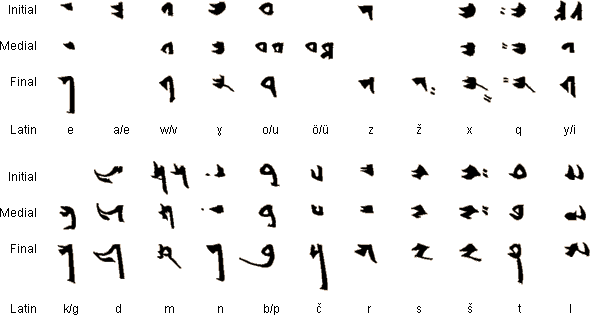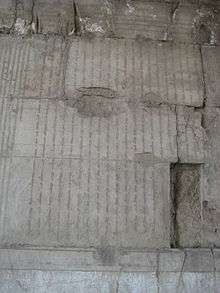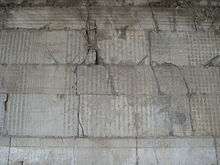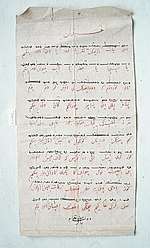Old Uyghur alphabet
The Old Uyghur alphabet was used for writing the Old Uyghur language, a variety of Old Turkic spoken in Turfan (also referred to as Turpan) and Gansu that is the ancestor of the modern Western Yugur language.[1] The term "Old Uyghur" used for this alphabet is misleading because Qocho, the Tocharian-Uyghur kingdom created in 843, originally used the Old Turkic alphabet. The Uyghur adopted this script from local inhabitants when they migrated into Turfan after 840.[2] It was an adaptation of the Aramaic alphabet used for texts with Buddhist, Manichaean and Christian content for 700–800 years in Turpan. The last known manuscripts are dated to the 18th century. This was the prototype for the Mongolian and Manchu alphabets. The Old Uyghur alphabet was brought to Mongolia by Tata-tonga.
| Old Uyghur alphabet | |
|---|---|
| Type | |
| Languages | Old Uyghur, Western Yugur |
Time period | ca.700s–1800s |
Parent systems | |
Child systems | Traditional Mongolian alphabet |
The Old Uyghur script was used between the 8th and 17th centuries primarily in the Tarim Basin of Central Asia, located in present-day Xinjiang Uygur Autonomous Region, China. It is a cursive-joining alphabet with features of an abjad and is written vertically. The script flourished through the 15th century in Central Asia and parts of Iran, but it was eventually replaced by the Arabic script in the 16th century. Its usage was continued in Gansu through the 17th century.[3]
Like the Sogdian alphabet (technically, an abjad), the Old Uyghur tended to use matres lectionis for the long vowels as well as for the short ones. The practice of leaving short vowels unrepresented was almost completely abandoned.[4] Thus, while ultimately deriving from a Semitic abjad, the Old Uyghur alphabet can be said to have been largely "alphabetized".[5]

Gallery
 Yuan dynasty Buddhist inscription written in Old Uyghur on the west wall of the Cloud Platform at Juyong Pass
Yuan dynasty Buddhist inscription written in Old Uyghur on the west wall of the Cloud Platform at Juyong Pass Yuan dynasty Buddhist inscription written in Old Uyghur on the east wall of the Cloud Platform at Juyong Pass
Yuan dynasty Buddhist inscription written in Old Uyghur on the east wall of the Cloud Platform at Juyong Pass- Slave contract
_vol_2.pdf.jpg) Contract on taxation
Contract on taxation Ming era text from volume with accompaning Chinese translation
Ming era text from volume with accompaning Chinese translation Yuan era epitaph
Yuan era epitaph Mehmed the Conqueror's Fetihname (Declaration of conquest) after the Battle of Otlukbeli
Mehmed the Conqueror's Fetihname (Declaration of conquest) after the Battle of Otlukbeli
References
- Osman, Omarjan. (2013). L2/13-071 Proposal to Encode the Uyghur Script.
- Sinor, D. (1998), "Chapter 13 - Language situation and scripts", in Asimov, M.S.; Bosworth, C.E. (eds.), History of Civilisations of Central Asia, 4 part II, UNESCO Publishing, p. 333, ISBN 81-208-1596-3
- Pandey, Anshuman. (2019). L2/19-016 Revised proposal to encode Old Uyghur in Unicode.
- Clauson, Gerard. 2002. Studies in Turkic and Mongolic linguistics. P.110-111.
- Houston, Stephen D. 2004. The first writing: script invention as history and process (p.59).
Bibliography
- Gorelova, Liliya M. (2002). Manchu Grammar. Brill. ISBN 978-90-04-12307-6.CS1 maint: ref=harv (link)
External links
| Wikimedia Commons has media related to Old Uyghur alphabet. |